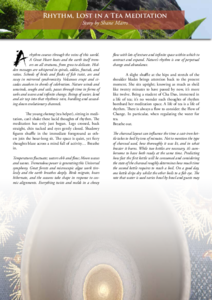
 |
|
A rhythm courses through the veins of this world. A Great Heart beats and the earth itself tremors on all stratums, from gross to delicate. Hidden messages are whispered in spirals, eddies, fractals, and ratios. Schools of birds and flocks of fish twist, arc and sway in mirrored synchronicity. Volcanoes erupt and cicadas awaken in chords of celebration. Nature winds and unwinds, soughs and sails, passes through time in forms of webs and waves and infinite change. Beings of water, land and air tap into that rhythmic vein, hurdling and cascading down evolutionary channels.

The young chatong (tea helper), sitting in meditation, can't shake these lucid thoughts of rhythm. The meditation has only just begun. Legs crossed, back straight, chin tucked and eyes gently closed. Shadowy figures shuffle in the immediate foreground as others join the hour-long sit. The space is quiet, yet fiery thoughts blaze across a mind full of activity... Breathe in.
Temperatures fluctuate; waters ebb and flow; Moon waxes and wanes. Tremendous power is generating this Universal symphony. Great forests and microscopic algae work tirelessly and the earth breathes deeply. Birds migrate, bears hibernate, and the seasons take shape in response to cosmic alignments. Everything twists and melds in a chewy flow with lots of texture and infinite space within which to contract and expand. Nature's rhythm is one of perpetual change and abundance.
A slight shuffle at the hips and stretch of the shoulder blades brings attention back to the present moment. She sits upright; knowing as much as she'd like twenty minutes to have passed by now, it's more like twelve. Being a student of Cha Dao, immersed in a life of tea; it's no wonder such thoughts of rhythm bombard her meditation space. A life of tea is a life of rhythm. There is always a flow to consider: the Flow of Change. In particular, when regulating the water for tea.
Breathe out.
The charcoal layout can influence the time a cast-iron kettle takes to boil by tens of minutes. Not to mention the type of charcoal used, how thoroughly it was lit, and in what brazier it burns. While two kettles are necessary, it's cumbersome to have both ready at the same time. Predicting how fast the first kettle will be consumed and considering the state of the charcoal roughly determines how much time the second kettle requires to reach a boil. On a good day, one kettle drips dry whilst the other boils to a fish eye. The rate that water is used varies bowl by bowl and guests may arrive and dissipate like birds on a power line. Of course, each tea itself lends to variance in preparation based on the amount and method of brewing. Where is the flow? When to put on the next kettle? What is the rhythm of change?

She grits her teeth like a threatened alley dog through the physical pain and mental calamity that build in unison, but remains cross-legged, determined to return to the soft center of her own rhythmic breath. Her eyes remain shut. Through her nostrils, the dry air is moistened, taken in deeply, and exchanged in exhalation. For a brief moment, her mind shines with silence like the full moon from behind a thin veil of clouds. Breathe in.
Tea rhythm happens in the course of a day, over the period of a week, throughout each month and within the year. Rhythm nested within rhythm where changing circumstances can cause a shift from one level to the next at any moment. Is this chaos or rhythm married to change? Surely, if any pattern is to be recognized, it must be done with great attention to detail, and only in the present moment. Flow is found in awareness and skilled reaction to that pattern. Rhythm is realized in a regular and intuitive response to that flow.
Calm, she remains poised, letting these thoughts pass just as they spontaneously arise. Not attached to having them, not attached to letting them go, and always resolved to return to the breath.
Breathe out.
What beautiful rhythm lies at the tea table. Mental music slowly subsiding, the sound of silence ever increasing, offering bowls full of tea, returning them empty to the heart - medicine for the people - fetching of water and exchanging of kettles, pouring from spouts and delicate sounds, steam rising and wavering, warming of lips and easing of tension, the final steeping, cleaning, this tea gathering dies to be born again. Through tea make friends.

Her mind wanders no more. For whatever time remains, she sits in inner stillness. Eternity. She has realized the base rhythm:
Breath in. Breath out.
It's not how many times your mind wanders, but how many times you bring it back.
